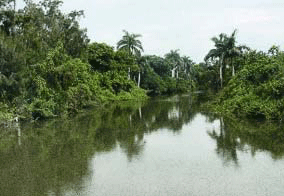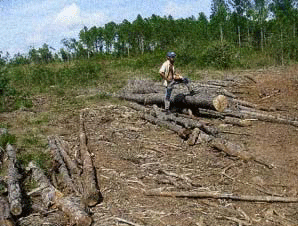Ecological forest farms, for their environmental regeneration of river basins
What problem does it solve?
Forestry resources and the Cuban population have evolved in different ways: from 1812 to 1900 wooded areas fell from 89% to 54%, while the population rose from 0.5 to 1 million inhabitants. Rapid development of the sugar industry led to disproportionate plundering of woodland areas to supply fuel for boilers and to satisfy the basic needs of the population in terms of food and social development.
This brought a rapid breakdown in both the hydrological cycle of Cuban agriculture, and the natural cycle of land use: forest - agriculture - livestock - forest.
The soil gradually became impoverished, reforestation was hardly attempted and the agricultural frontier expanded horizontally. No ecological criteria were used to maintain soil structure and fertility, which are fundamental for sustainable production of forest and farm products.
From 1900 to 1959, the situation just got worse. Woodland dropped to 14% of the total, while the population reached 6.9 million. In this period, barely 6,000 hectares were reforested, not enough to form a permanent dynamic agricultural balance: woods – agriculture – livestock.
Now, 44 years later, in contrast to the previous situation, 21.9%, of the country is woodland, after more than 440,000 hectares have been reforested. Over the same period, the population has gone up to 11 million inhabitants. This provides a forest/population ratio of 0.22 hectares per capita, which is the amount of woodland available to every Cuban, who can thus reap the benefits of the goods and services of this extremely valuable natural resource.
While these trends in forest resources and the population were in progress, bad soil management meant that 4.9 million hectares of agricultural land and grazing areas suffered from erosion. The main problems regarded compaction, (1.4), poor moisture retention (1.1), acidity, stoniness (1.4), and salinity (1).
Water resources, too, which benefit from the regulatory, anti-erosive and protective capacities of forests, evolved over time and space. While woodland declined, capacity for storing annual surface water flow (more than 7,000 million cubic metres) was increased by constructing 241 expensive large-scale hydraulic works and more than 750 small reservoirs.
This situation underlines the importance of continuing the sustainable development provided by the ecological forest farm movement, which aims to reverse the problems of soil degradation, increase woodland areas and extend the life span of hydraulic works. Agricultural, livestock and woodland areas are all distributed in 632 river basin areas of over five square kilometres, which handle 80 % of annual water flow, an estimated 27,700 million cubic metres.
The Cuban Agriculture Ministry, through the GEAM, which oversees the Ecological Forest Enterprise System, the IIF, and the SEF, has set up 848 forest farms, with medium term plans for 5,000 more. The IIF and the network of experimental stations provide training and advice for the technical personnel of forest companies and the forest farmers, which it does through research and applied technology.
The SEF approves proposals for forest farms projects, controls and certifies success and survival rates in plantations, and allocates bonuses for forestry activities as provided for in the Forestry Law. The municipal government also takes part in this process, through commissions set up in every municipality of the country to control reforestation, protect woodland, and safeguard the environment in general.
In financial terms, many farms established in unproductive lands have produced tangible results (direct wood products) and balanced budgets, taking into account reforestation activities, certification, bonuses, investment and other. After six years work in this new form of forestry organisation, farmers have made net earnings of USD 71,133.
Technically, forestry development has benefited substantially from technology developed by research activities, at both the national and international level. Capacity building programmes for technical personal and forest farmers give them the basic technological know-how for productive management. The environment, too, has gained from an increased variety of forest cultivars planted in lands that used to be deforested. Riverbanks and the margins of large reservoirs have also been rapidly reforested to protect water quality. This, moreover, has a positive effect on wildlife by increasing potential for shelter and protection.
The ecological forest farm movement has helped create living conditions that benefit family welfare and have given farmers a broad sense of social belonging. This can be seen not only in terms of productivity, but also in forest care and protection from the dangers of deliberate fires, illegal logging, disease and illness. It also encourages rural populations to stay on the land and curbs migration to cities by providing work and access to basic social services, increasing the quality of life for the people living in forest farm areas.
Although results are only just beginning to show, this novel form of forestry production and protection has been the subject of debate in various national and international events, papers and conferences, which have recognised its value and encouraged authorities to continue applying this method in all the country’s forestry enterprises.
DOWNLOAD THE BROCHURE PDF
english (1.2 MB)spanish (1.1 MB)








 COUNTRY OF ORIGIN
COUNTRY OF ORIGIN